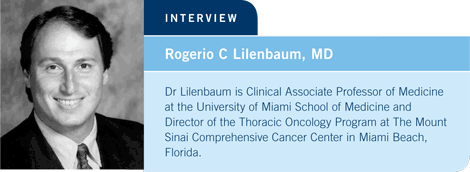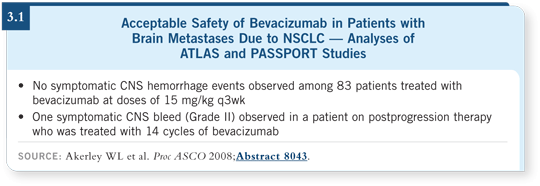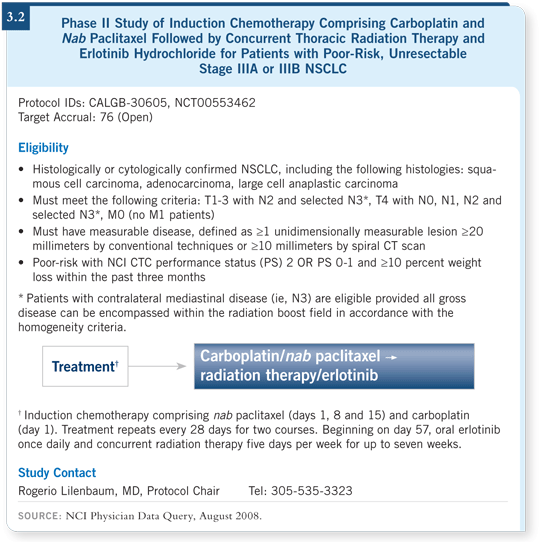
 |
|||||||

| Tracks 1-12 | ||||||||||||||||||||||||||
|
Select Excerpts from the Interview
Track 4
![]() DR LOVE: Can you discuss the results of the AVAiL study?
DR LOVE: Can you discuss the results of the AVAiL study?
![]() DR LILENBAUM: AVAiL was a European trial evaluating cisplatin/gemcitabine
with or without bevacizumab at two different doses, 7.5 milligrams per
kilogram and 15 milligrams per kilogram (Manegold 2007). There was a
statistically significant difference in the study’s main endpoint of progression-free
survival. Although the difference in the median progression-free survival
among the three arms was modest, the improvement was statistically significant.
The hazard ratio wasn’t as positive as the hazard ratio for the ECOG-E4599
trial (Sandler 2006).
DR LILENBAUM: AVAiL was a European trial evaluating cisplatin/gemcitabine
with or without bevacizumab at two different doses, 7.5 milligrams per
kilogram and 15 milligrams per kilogram (Manegold 2007). There was a
statistically significant difference in the study’s main endpoint of progression-free
survival. Although the difference in the median progression-free survival
among the three arms was modest, the improvement was statistically significant.
The hazard ratio wasn’t as positive as the hazard ratio for the ECOG-E4599
trial (Sandler 2006).
A recent press release regarding the AVAiL study indicated that no difference appeared in overall survival (Genentech 2008), but we have yet to see the data.
We were hoping to see results at ASCO, but I believe we’ll have to wait until the fall European meeting.
Track 5
![]() DR LOVE: Bevacizumab is commonly being used in NSCLC. How do
the issues of hemoptysis and pulmonary hemorrhage play out in your
practice?
DR LOVE: Bevacizumab is commonly being used in NSCLC. How do
the issues of hemoptysis and pulmonary hemorrhage play out in your
practice?
![]() DR LILENBAUM: I have the sense that physicians have become more comfortable
with bevacizumab. They use it in NSCLC, colorectal cancer and in breast
cancer. People are aware of the pulmonary hemorrhage issue, but it doesn’t
seem to be an impediment the way it was when ECOG-E4599 was first
presented.
DR LILENBAUM: I have the sense that physicians have become more comfortable
with bevacizumab. They use it in NSCLC, colorectal cancer and in breast
cancer. People are aware of the pulmonary hemorrhage issue, but it doesn’t
seem to be an impediment the way it was when ECOG-E4599 was first
presented.
The limited analysis presented by the E4599 authors at ASCO 2008 indicated a trend toward a higher rate of pulmonary hemorrhage for people with cavitation, but it wasn’t statistically significant (Sandler 2008). We were dealing with small numbers overall. I believe that raises a concern, but I don’t know that this means that patients who receive bevacizumab and develop cavitation within the tumor should not receive it.
I believe other issues with regard to bevacizumab have been overcome. Solid data now exist to support the use of bevacizumab for patients with brain metastases after they’ve received definitive treatment and are neurologically stable (Akerley 2008; [3.1]). I find that to be a significant step forward because we were excluding a large group of patients from receiving bevacizumab.
![]() DR LOVE: Can you review the issue of anticoagulation in terms of AVAiL
versus ECOG-E4599?
DR LOVE: Can you review the issue of anticoagulation in terms of AVAiL
versus ECOG-E4599?
![]() DR LILENBAUM: The main difference was that although patients who’d had
thromboembolic phenomena were not eligible for either trial, if patients on
AVAiL developed one of these complications while receiving bevacizumab,
they were allowed to continue the bevacizumab with full anticoagulation.
These individuals did not have significantly higher rates of pulmonary hemorrhages
or bleeding complications.
DR LILENBAUM: The main difference was that although patients who’d had
thromboembolic phenomena were not eligible for either trial, if patients on
AVAiL developed one of these complications while receiving bevacizumab,
they were allowed to continue the bevacizumab with full anticoagulation.
These individuals did not have significantly higher rates of pulmonary hemorrhages
or bleeding complications.

Track 7
![]() DR LOVE: What are your thoughts on the adjuvant ECOG-E1505 trial
evaluating bevacizumab with chemotherapy?
DR LOVE: What are your thoughts on the adjuvant ECOG-E1505 trial
evaluating bevacizumab with chemotherapy?
![]() DR LILENBAUM: We have five patients on this study, and we’ve had no major
complications so far. Interestingly, I believe only one of those five patients was
randomly assigned to bevacizumab, so we haven’t had to deal with maintenance
yet.
DR LILENBAUM: We have five patients on this study, and we’ve had no major
complications so far. Interestingly, I believe only one of those five patients was
randomly assigned to bevacizumab, so we haven’t had to deal with maintenance
yet.
![]() DR LOVE: That study allows docetaxel, vinorelbine or gemcitabine in combination
with cisplatin. What are you generally using?
DR LOVE: That study allows docetaxel, vinorelbine or gemcitabine in combination
with cisplatin. What are you generally using?
![]() DR LILENBAUM: I administer either cisplatin/docetaxel, with prophylactic
growth factors, or cisplatin/gemcitabine. Cisplatin/docetaxel is a once every
three-week regimen, and most patients will not require a port.
DR LILENBAUM: I administer either cisplatin/docetaxel, with prophylactic
growth factors, or cisplatin/gemcitabine. Cisplatin/docetaxel is a once every
three-week regimen, and most patients will not require a port.
The typical cisplatin/vinorelbine regimen is 12 doses and is difficult to administer without an indwelling catheter, which adds complexity and inconvenience. I’m surprised by how many lung cancer investigators and institutions have adopted the cisplatin/vinorelbine combination, although I can understand why — because of the data from the international adjuvant trials.
Track 11
![]() DR LOVE: Would you discuss the CALGB trial in Stage III disease that
you are chairing?
DR LOVE: Would you discuss the CALGB trial in Stage III disease that
you are chairing?
![]() DR LILENBAUM: CALGB has just opened a study evaluating patients with
poor-risk Stage III disease treated with induction carboplatin/nab paclitaxel
followed by radiation therapy and erlotinib (3.2).
DR LILENBAUM: CALGB has just opened a study evaluating patients with
poor-risk Stage III disease treated with induction carboplatin/nab paclitaxel
followed by radiation therapy and erlotinib (3.2).
Nab paclitaxel is arguably a more tolerable taxane for patients susceptible to toxicity. Erlotinib is used only for the duration of the radiation therapy — it is not used for maintenance. This is a pure radio-sensitizing question independent of clinical or molecular predictors.
This is a neglected subset of patients. If you examine the Stage III literature, you see that it is restricted essentially to patients with PS 0 to 1 and no significant weight loss.
This is less than five percent of patients. An enormous group of patients don’t fit the eligibility for the major clinical trials, and that has led, directly or indirectly, to our current positions on combined modality therapies.
A past CALGB trial evaluating gefitinib in a small number of patients with PS 2 or greater showed promising results (Zinner 2004). A precedent exists for trying to develop a regimen for patients who are not felt to be good candidates for combined chemotherapy and radiation therapy.

| Table of Contents | Top of Page |
EDITOR
Neil Love, MD
INTERVIEWS
Thomas J Lynch, MD
- Select publications
F Anthony Greco, MD
- Select publications
Robert Pirker, MD
- Select publications
Lung Cancer Update:
A CME Audio Series and Activity